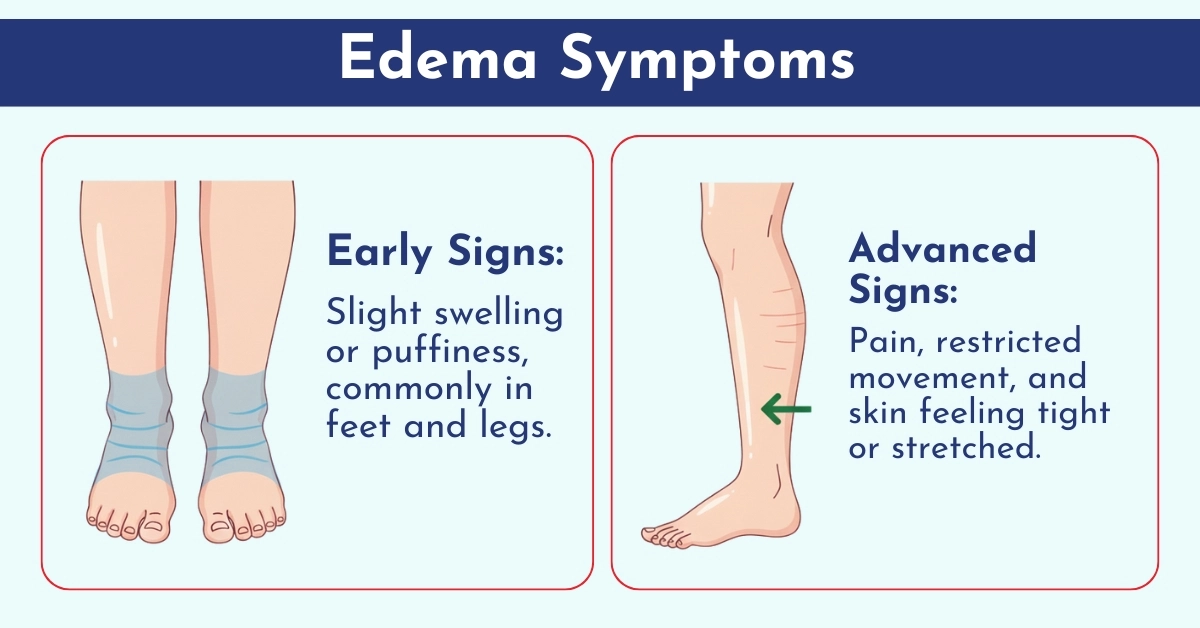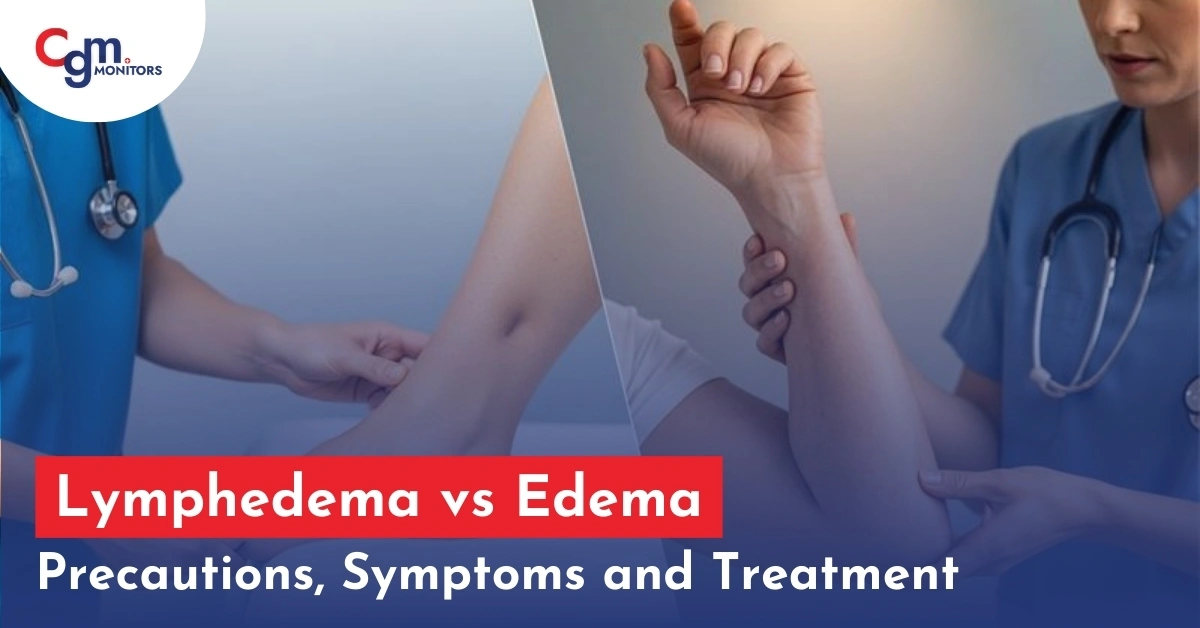Table of content
Edema is the medical term used for swelling, which is a normal effect of certain reactions and injuries. Edema (swelling) that lasts longer should be diagnosed and treated. This is a wider term, and lymphedema is a type of it caused by a problematic lymphatic system. This specific type is generally categorized into 4 stages, from stage 0 to 3. Thus, ‘Lymphedema vs Edema’ does not make much sense; instead, the question should be whether it’s edema or one of its specific types, i.e., Lymphedema.
Unsure about the Lymphatic system? It is a group of vessels, tissues, and organs that help with healthy fluid management in your body. A deep dive into the differences between lymphedema and edema.
Characteristics and Types of Edema
Edema is simply the lumps caused by the accumulation of fluid in the tissues, often in the lower body. You may witness this for multitudinous reasons, including injury, minimal mobility, or indeed high sugar levels. Edema has various types, affecting different areas of our body.
Types of Edema
Peripheral (affecting legs, arms, feet, ankles, and hands), pulmonary (affecting lungs and therefore causing difficulty in breathing), Cerebral (affecting the brain), and macular (affecting the eyes).
Characteristics of Edema
Pitting (involving water retention and thus leaving an indentation when pressed), and non-pitting edema (often due to tissue accumulation or protein drainage, and this one leaves no indentation upon pressing).
Edema Treatments, Common Onset Age, & Symptoms
Treating edema generally involves addressing the underlying cause. For example, reducing salt intake (as salt supports fluid retention), elevating the legs, and wearing compression socks can help reduce swelling.
Common Age of Onset
Edema can affect people at any age, but it is more common in older adults or individuals with certain medical conditions.
Do you know?
Pneumatic compression devices like Bio Compression are helping people deal with fluid accumulation issues. These devices come with various chamber options and compression garments (bought separately).
Check out your eligibility for a Bio Compression device today with CGM Monitors, enjoy quick approvals and delivery of the product at your door at no additional costs (within the USA).
Symptoms of Edema
- Early symptoms: Mild lump, especially in the legs or feet.
- Later symptoms Include Pain, difficulty moving the affected area, and skin tightness.
Do you have Healthy Kidneys?
Poor kidneys can contribute to lymphatic system damage. The accumulation of which can lead to lymphedema.

Lymphedema Stages, Treatments, & Symptoms
A worsened chronic edema, Lymphedema is a condition where lymph fluid builds up (accumulation of protein-rich lymphatic fluid) due to a blockage or damage to the lymphatic system. This condition is most generally seen in people who have had lymph nodes removed, such as after cancer treatment.
Lymphedema Stages
There are 4 stages of Lymphedema, with the starting stages being easy and treatable, the later stages are severe and non-reversible:
- Stage 0: Only the feeling of heaviness with no visible signs in the affected area.
- Stage 1: Swelling that goes away when that specific part is elevated.
- Stage 2: The affected space stays swollen most of the time, enough that this area becomes hard.
- Stage 3: The color of this affected area also starts to change.
More information on the 4 stages of Lymphedema.
Prevention and Treatment
To take an example, preventing lymphedema after lymph node removal involves:
- Gentle movement and avoiding trauma.
- Regular massage therapy, contraction garments, and exercises are important in managing lymphedema.
- Early treatment can help manage symptoms, but there’s no given cure, making lymphedema treatment a permanent one.
Important: While lymphedema therapists, with the help of massage sort of therapy, can help you with manual lymph drainage, it should be avoided by people who have blood clots, cancer, or skin infections.
Common Age of Onset
Lymphedema generally occurs in grown-ups, frequently after surgery or radiation therapy in the case of cancer. However, it can also appear in children due to natural issues with the lymphatic system.
Symptoms of Lymphedema
- Early symptoms: Swelling, heaviness, and pain in the limbs.
- Later symptoms: Skin changes, infections, and severe lumps that may appear endlessly.
Lymphedema vs Edema Comparison Table
| Feature | Lymphedema | Edema |
| Common Age of Onset | Typically, after surgery, cancer treatments | Can occur at any age, more common in older adults |
| Early Symptoms | Swelling, itching, tightness in limbs, and more (explained above) | Swelling in feet, legs, or hands |
| Later Symptoms | Skin thickening, infections | Persistent swelling, discomfort |
| Effects on the Body | Affects mostly the arms, legs, neck, and face | affect any part of the body, most often legs |
| Treatments that Carry Risk | Surgery,, radiation therapy | Diuretics can lead to dehydration |
| Treatment Possibilities | Manual lymphatic drainage, compression therapy, and exercises | Address underlying causes, elevate limbs |
| Effects of Regular Exercise | Helps reduce swelling, improves circulation | Reduces fluid retention and swelling |
| Best Workouts | Swimming, cycling, yoga | Walking, gentle stretches, swimming |
| Best Diet | Low-sodium, anti-inflammatory foods | Low-sodium, high-potassium foods |
| Suitable Herbs | Horse chestnut, calendula | Dandelion, parsley, ginger |
| Commonly Used Drugs | Diuretics, antibiotics (for infections) | Diuretics,, pain relievers |
| Least Side Effects | Compression therapy, exercise | Proper hydration and diet adjustments |
Can Lymphedema or Edema Be Fully Treated?
Unfortunately, Lymphedema, as verified by MayoClinic, cannot be fully cured. Still, with early diagnosis, treatment, and continuous management, the symptoms can be controlled, and the quality of life can be improved.
Edema occurs due to underneath problems in your body, and resolving the underlying condition generally treats edema, frequently resulting in vanished swelling. Still, some cases may require ongoing management, especially for chronic edema.
Frequently Asked Questions
Is edema the same as lymphedema?
Edema is a general medical term for swelling and has several types. Lymphedema is a type of edema caused by a problematic lymphatic system.
How to prevent lymphedema?
Avoid needle sticks, prolonged sitting, or standing; instead, move frequently. Edema or Lymphedema are results of other issues in your body; maintaining overall good health can help you avoid them.
Disclaimer: This blog is for informational purposes only and does not constitute medical, legal, or professional advice. While we strive for accuracy, errors or omissions may occur.







Write a comment
Your email address will not be published. All fields are required